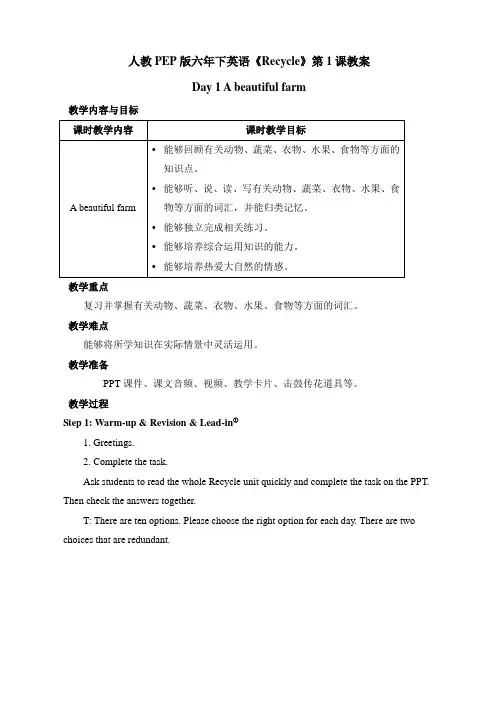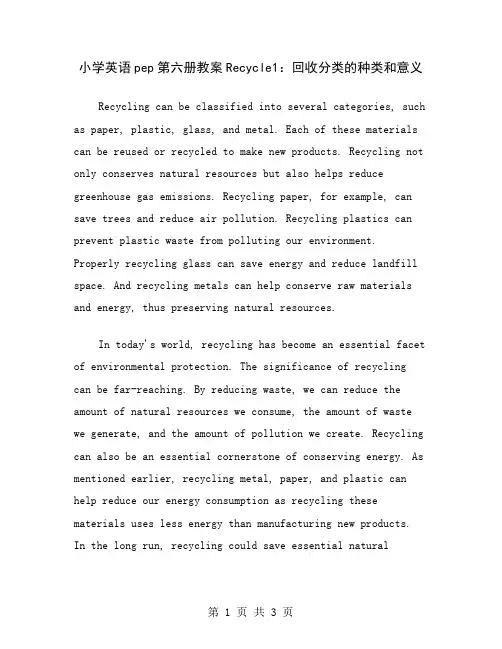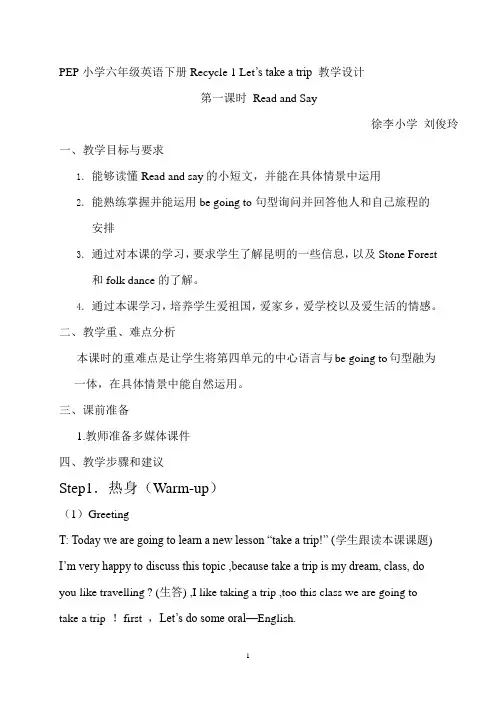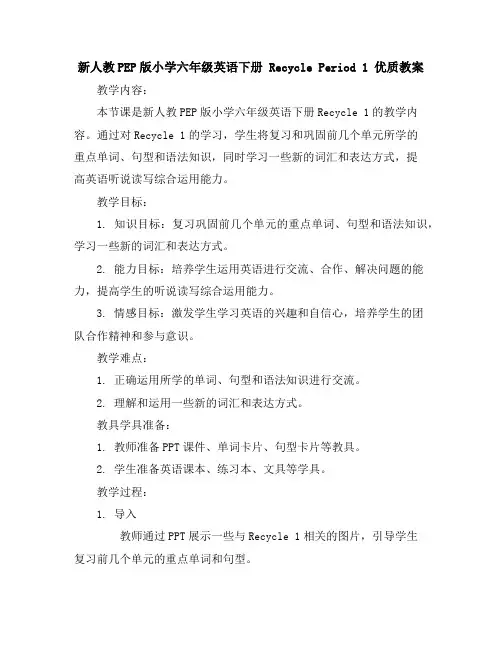PEP版六年级下册英语Recycle1教案-1
人教PEP版-英语-六年级下册--Recycle 1 教案案例一

Let us take a trip 第一课时教案示例一、教学重点:让学生将1-3单元的重点语言项目融为一体,在具体情景中能自然运用。
二、教学难点:让学生在具体情境中熟练运用be going to句型询问和回答有关信息。
三、课前准备:1、教学过程中所需的图片、录音、课件、音乐素材。
2、连词组句活动要用的单词卡片。
四、教学过程:Warm up (热身)活动一:Sing it教学参考时间:2分钟教师播放四单元歌曲“A Trip to China”,学生跟唱。
Review (复习)活动二:cities教学参考时间:3-4分钟教师播放课件或地图、图片等呈现祖国各地风貌,让学生初步感知各地自然风光及民俗风情。
请学生说出图中人物来自哪个城市,复习Where is he/she from?及城市名称。
提问:Where is he/she from? He’s/She’s from ….(城市包括香港、上海、云南、北京、广州、澳门、哈尔滨等)3、Presentation (新课呈现)活动三:Guessing Game教学参考时间:8-9分钟教师介绍刚才图中的同学都是自己的朋友,要去拜访他们,请大家猜一猜老师要去哪儿。
教师提问:Where am I going to visit? 播放音乐“月光下的凤尾竹”,并配合介绍说:“It’s usually warm and sunny. It’s known as ‘Spring City’”。
引导学生猜出:You’re going to visit Kunming.教师出示石林和少数民族舞蹈的图片,同时教学短语Stone Forest和folk dance。
教师可结合图片、音乐、录像等辅助材料学习短语folk music/clothes/dance等。
活动四:Collecting information教学参考时间:8-9分钟教师简单介绍对话背景,板书Where, What, When, How四个疑问词并放对话录音,让学生边听边记录主要信息。
人教PEP版六年下英语《Recycle》第1课教案

人教PEP版六年下英语《Recycle》第1课教案Day 1 A beautiful farm教学内容与目标教学重点复习并掌握有关动物、蔬菜、衣物、水果、食物等方面的词汇。
教学难点能够将所学知识在实际情景中灵活运用。
教学准备PPT课件、课文音频、视频、教学卡片、击鼓传花道具等。
教学过程Step 1: Warm-up & Revision & Lead-in①1. Greetings.2. Complete the task.Ask students to read the whole Recycle unit quickly and complete the task on the PPT. Then check the answers together.T: There are ten options. Please choose the right option for each day. There are two choices that are redundant.3. Enjoy a chant.Enjoy the chant in Part A of Unit 4 in Grade 4. (课件出示:四年级下册教材P39 Let’s chant的相关内容)Let’s students chant together with the tea cher.4. Lead-in.Present a picture of a beautiful farm. (课件出示:一张漂亮的农场图片)T: Welcome to the beautiful farm. I hope you can have a good time here! Are you ready to go?Ss: Yes.T: Let’s go!◆Teaching purpose①整个复习部分是一个整体,所以先让学生构建整体情景框架,基于整体情景构建文字意义,再进入各部分教学。
小学英语pep第六册教案Recycle1:回收分类的种类和意义

小学英语pep第六册教案Recycle1:回收分类的种类和意义Recycling can be classified into several categories, such as paper, plastic, glass, and metal. Each of these materials can be reused or recycled to make new products. Recycling not only conserves natural resources but also helps reduce greenhouse gas emissions. Recycling paper, for example, can save trees and reduce air pollution. Recycling plastics can prevent plastic waste from polluting our environment. Properly recycling glass can save energy and reduce landfill space. And recycling metals can help conserve raw materials and energy, thus preserving natural resources.In today's world, recycling has become an essential facet of environmental protection. The significance of recycling can be far-reaching. By reducing waste, we can reduce the amount of natural resources we consume, the amount of waste we generate, and the amount of pollution we create. Recycling can also be an essential cornerstone of conserving energy. As mentioned earlier, recycling metal, paper, and plastic can help reduce our energy consumption as recycling these materials uses less energy than manufacturing new products.In the long run, recycling could save essential naturalresources and reduce greenhouse gas emissions that drive global warming.Apart from helping the environment, recycling can also have a significant economic impact. The recycling industry creates jobs, generates revenue, and reduces waste management costs. Recycling can also be an essential contributor to sustainable development as it aligns with several of the United Nations' 17 Sustainable Development Goals (SDGs).Recycling's benefits also extend to preserving wildlife habitats and protecting endangered species. The waste generated by humans can have severe consequences on the environment, and recycling can help mitigate these adverse effects. When we recycle, we save natural resources needed to maintain ecosystems, thereby preserving the habitats andlives of countless plant and animal species.In conclusion, recycling is a crucial aspect of our daily lives, and the importance of teaching our children about the benefits of recycling cannot be understated. The different types of recycling, their economic, environmental, and social impacts should be made clear to students. Educating children about recycling practices can help them cultivate a sense of responsibility and respect for the environment from a youngage. As the saying goes, "it takes a village to raise a child." We should all play our part by educating ourselves and our children to promote sustainable behaviors that will help us live in harmony with Mother Nature.。
小学英语教案:pep六年级下册Recycle 1

pep六年级英语下册Recycle 1教案课题六年级下册recycle 1(第一课时)教学目标 1、能读懂 read and say 的小短文,并能完成相应的两项练习。
2、能熟读运用 be going to 句型询问并回答自己及他人的旅行安排。
教学重点本课时的教学重、难点是将第四单元的中心语言与 be going to 句型融为一体,让学生在具体情景中能熟练自然地运用。
教学难点本课时的教学重、难点是将第四单元的中心语言与 be going to 句型融为一体,让学生在具体情景中能熟练自然地运用。
教具准备 1、教师准备多媒体图片:中国地图和各地风景图(包括stone forest 和 folk dance 图片)。
2、教师准备一个旅行包。
3、教师准备民乐《月光下的凤尾竹》;本课时录音带;mike 的头饰;相关单词卡片。
导学过程二次备课教学步骤1、warm-up(1) 播放六年级上册unit 3 歌曲“what are you going to do ?”what are you going to ,going to ,what are you going to do on saturday ?i’m going to the park ,to the park .i’m going to the park on saturday.where are you going ,going ?where are you going on saturday ?i’m going to the zoo, to the zoo. i’m going to the zoo on saturday .师生跟唱。
(复习回顾两个句型)(2)师运用地图,呈现祖国各地风景,让学生初步感知各地自然风光、民俗风情及地名。
(3)学生根据实际经历自由回答:where did you go /visit on your holiday ?i went to/visited ….on my holiday .请访问同一地名的同学组成family , 做到相邻的位置。
Pep_8_小学六年级英语下册Recycle_1_Let教案

PEP小学六年级英语下册Recycle 1 Let’s take a trip 教学设计第一课时Read and Say徐李小学刘俊玲一、教学目标与要求1.能够读懂Read and say的小短文,并能在具体情景中运用2.能熟练掌握并能运用be going to句型询问并回答他人和自己旅程的安排3.通过对本课的学习,要求学生了解昆明的一些信息,以及Stone Forest 和folk dance的了解。
4.通过本课学习,培养学生爱祖国,爱家乡,爱学校以及爱生活的情感。
二、教学重、难点分析本课时的重难点是让学生将第四单元的中心语言与be going to句型融为一体,在具体情景中能自然运用。
三、课前准备1.教师准备多媒体课件四、教学步骤和建议Step1.热身(Warm-up)(1)GreetingT: Today we are going to learn a new lesson “take a trip!” (学生跟读本课课题)I’m very happy to discuss this topic ,because take a trip is my dream, class, doyou like travelling ? (生答) ,I like taking a trip ,too this class we are going totake a trip !first ,Let’s do some oral—English.a. What’s the weather like today ?b. What day is it today ?c. What did you do yesterday ?d. What are you going to do after school ?……. 学生根据教师的话题聊一聊自己平时的生活。
T: just now you say so many about yourself, and today we are going to learn this English class in the computer room ,I’m very happy ?(问两名学生) how do you feel ?(问所有的学生) how do you feel ?(学生回答) I’m glad to hearthat ,I’m v ery happy too ,OK, class , you are very happy and we are allhappy ,too,so let’s sing a happy song :if you are happy.(媒体播放)if you are happy(学生跟唱)Step 2.复习(Review)T: OK ,after the beautiful song ,are you happy? please let your happiness go on .Summer holiday is coming, It’s the good season for trip复习几个疑问词:where,when,what,who,how句型.Step 3. 新课呈现(Presentation)(1)引入由Guess 环节引入,I am going to take a trip. It’s usually warm and sunny. It’s known as “Spring City”.Where am I going ?引出Mike is going to visit Kunming.简介昆明(2)新授①listen and answerWhere is Mike going on his holiday?②Listen again and answer:.Who is Mike going with?.What is he going to do in Kunming?③Ask the students to read the dialogue on page 50,and fill in Mike’s trip schedule on P51④简介folk dances和stones⑤跟读短文让学生跟着录音模仿短文的语音和语调Step 4 practice①Retell the passageMike is going to visit ________ ___________.He’s going there with his ____, his ____ and his _____ _______.They’re going by ______.Mike is going to ______________ and _________________.They will have a good time in _________.②Talk about your holiday plans with your partnersI’m___. I am a student. I’m going to___with_my__this summer holiday. We are going there___. In___we are going to___.And we are going to___. It must be fun. I can’t wait.Step 5 Homework:1.完成英语练习册第45页。
新人教PEP版小学六年级英语下册Recycle Period1优质教案

新人教PEP版小学六年级英语下册 Recycle Period 1 优质教案教学内容:本节课是新人教PEP版小学六年级英语下册Recycle 1的教学内容。
通过对Recycle 1的学习,学生将复习和巩固前几个单元所学的重点单词、句型和语法知识,同时学习一些新的词汇和表达方式,提高英语听说读写综合运用能力。
教学目标:1. 知识目标:复习巩固前几个单元的重点单词、句型和语法知识,学习一些新的词汇和表达方式。
2. 能力目标:培养学生运用英语进行交流、合作、解决问题的能力,提高学生的听说读写综合运用能力。
3. 情感目标:激发学生学习英语的兴趣和自信心,培养学生的团队合作精神和参与意识。
教学难点:1. 正确运用所学的单词、句型和语法知识进行交流。
2. 理解和运用一些新的词汇和表达方式。
教具学具准备:1. 教师准备PPT课件、单词卡片、句型卡片等教具。
2. 学生准备英语课本、练习本、文具等学具。
教学过程:1. 导入教师通过PPT展示一些与Recycle 1相关的图片,引导学生复习前几个单元的重点单词和句型。
学生跟随教师一起回顾所学的知识,并尝试用英语进行简单的交流。
2. 新课展示教师通过PPT展示一些新的词汇和表达方式,并引导学生进行学习和模仿。
学生跟随教师一起学习新的知识,并尝试用英语进行简单的交流。
3. 练习巩固教师设计一些练习活动,帮助学生巩固所学的知识。
学生通过完成练习,加深对单词、句型和语法的理解和运用。
4. 小组活动教师将学生分成小组,布置一些任务,让学生在小组内用英语进行交流合作。
学生通过小组活动,提高英语听说读写综合运用能力,培养团队合作精神。
学生展示自己的学习成果,教师给予肯定和鼓励。
板书设计:1. 新人教PEP版小学六年级英语下册 Recycle 12. 主要内容:单词、句型、语法知识3. 重点:单词、句型、语法知识的运用作业设计:1. 完成练习册上的相关练习题。
2. 复习巩固所学的单词、句型和语法知识。
pep六年级英语下册Recycle 1教案
PEP六年级英语下册Recycle 1教案教学目标1.掌握词汇:breathe(呼吸)、pollution(污染)、save(节约)、environment(环境)、throw(扔)、recycle(回收)。
2.学会正确使用句型:What should we do? We should + 动词原形。
3.能够通过讨论环保行为,培养学生对环保意识和责任感。
教学重点1.学生能正确理解并使用所学词汇。
2.学生能够运用所学句型进行口头表达。
教学准备1.教师准备投影仪和相关教学媒体。
2.学生准备笔记本和铅笔。
教学步骤第一步:导入新课1.教师与学生打招呼,并介绍本课的主题“Recycle 1”。
2.向学生展示图片或视频,引导学生探讨不同的环保行为。
3.教师可以提问:“你知道什么是环保吗?你是否参与过环保行动?”第二步:引入新词汇1.教师出示单词卡片,分别教授单词“breathe”、“pollution”、“save”、“environment”、“throw”、“recycle”的发音和意义。
2.教师可借助图片等教具帮助学生理解词汇。
第三步:练习句型1.教师出示句型“What should we do?”并解释其意义。
2.教师用例句“我们应该打开窗户呼吸新鲜空气”引导学生回答应该做什么。
3.学生跟读句型并回答问题。
第四步:口头练习1.教师带领学生模仿句型,自由组合它们,讨论环保行为。
2.教师可以提供一些例子,如“我们应该节约用水”、“我们应该回收垃圾”等。
3.学生按照教师的示范进行口头练习。
第五步:板书总结教师总结本课学习的内容,将重点单词和句型写在黑板上,供学生复习。
课后作业1.学生整理课堂笔记,复习所学内容。
2.要求学生在家中寻找其他的环保行为,并整理成一份小报告。
教学反思本课通过导入的方式引起学生的兴趣,激发他们对环保的思考。
通过讨论环保行为和引入新词汇,学生掌握了一些基本的环保词汇和句型。
同时,口头练习使学生能够运用所学内容进行表达和交流。
小学英语pep第六册教案Recycle1:如何在生活中进行回收分类行动
小学英语pep第六册教案Recycle1:如何在生活中进行回收分类行动Recycling is a process of turning waste materials into new products. It not only reduces the amount of waste that ends up in landfills, but also conserves natural resources and energy. As responsible citizens, it is important for us to practice recycling in our daily lives. This lesson is designed to teach our young learners how to recycle and sort different materials.Materials:-Pictures of recyclable and non-recyclable items-Sorting chart-Recycling binIntroduction:-Show the pictures of different materials such as paper, plastic, glass, aluminum, and explain what they are and how they are used.-Discuss the concepts of reduce, reuse, and recycle as ways to manage waste.Body:1.Sorting game-Divide students into small groups and give them some recyclable and non-recyclable items.-Ask them to sort the materials into the correct category using the sorting chart.-Have each group present their sorted materials and the reasoning behind it.2. Recycling story-Read a story about a family who practices recycling in their daily lives.-Ask questions and discuss the importance of recycling.3. Recycling craft-Ask students to bring empty plastic bottles to class.-Show them how to turn the bottles into plant pots or pencil holders by cutting off the top part and decorating the surface.Conclusion:-Summarize the importance of recycling and encourage students to practice it in their daily lives.-Show them where the recycling bins are located in the school and explain what items can be placed in them.-Encourage students to share their recycling stories or ideas with their family and friends.Assessment:-Observe if students are able to sort the materials correctly and explain their reasoning.-Evaluate the finished recycling craft for creativity and functionality.By actively participating in this lesson, students will have gained a better understanding of the importance of recycling and how to practice it in their daily lives. They will take home this knowledge and spread the message to their families, friends and communities. Let us do our part in protecting the environment and conserving our precious resources.。
最新人教PEP版小学英语六年级下册 Recycle 第1课时优质课教学设计
最新人教PEP版小学英语六年级下册优质课教学设计Recycle第1课时(Day 1, Day 2 and Day 3)教学目标一、知识与技能1. 会给单词归类。
2. 去市场之前会列好清单。
3. 能介绍新朋友的外貌特征。
4. 能描述农场生活和活动。
二、过程与方法本部分是一个情景对话,在对话中复现了1-4单元的对话与短语,教师可以组织学生复习所学过的句型,进行语言知识归纳,然后再引入情景对话文本的学习。
三、情感、态度与价值观培养学生乐于开口,敢于开口讲英语的习惯,激发学生想学、乐学英语的兴趣和愿望。
教学重点1. 能理解对话内容。
2. 能听懂单词的发音。
教学难点听懂单词的发音。
教法导航主要通过各种方式创建环境让学生进行对话练习。
学法导航学生要积极预习,参加小组探究活动,进行小组竞争。
教学准备多媒体课件,教学挂图,学生活动手册等。
教学过程一、热身(Warm-up)让学生根据实际情况回答问题(以下可参考):What day is today?What did you have on Monday?二、呈现新课(Presentation)1. 教师利用课件出示一些场景,如:农场、学生由此展开联想,说说在这些场景中我们学过的单词。
动物园、果园、衣橱、超市。
学生如看到动物园,可以说tiger。
2. 教师出示插图,先让学生仔细看然后让其选择,全班校对答案,让一些学生来说说a、an、some的用法。
教师提问:What else can you see?学生说说画面中的其他物品。
3. 教师出示第42页下图,引导对单词归类并记忆所有单词。
4. 教师出示思维导图,引导学生帮助完成思维导图,并根据例图,和同伴完成类似的思维导图,并与全班同学一起分享。
5. 出示第43页的下图展示描述人的单词和句子,和同伴一起利用所给单词和词汇对图中人物进行描述。
在组内或全班同学面前进行描述。
6. 教师出示Life on the farm 中的挂图,学生看图,并按照要求划出相应的词,并根据图片提示完成句子。
PEP版六年级下册英语Recycle1_Let's_Take_a_Trip!教案及反思
PEP人教版六年级下册Recycle 1 Let’s Take a Trip!(Read and say)Ⅰ. Teaching aims:1. Emotion goal: Respecting the culture of the minority nationality and lovingour country.2. Knowledge goal: Use the sentence pattern “be going to” in a trip and the pasttense of verbs.3. Ability goal: Can use the sentence patterns “be going to”.Ⅱ.Content analysis1. Importance: The new words, sentences drills :Where are you going on your holiday? Who are you going with? What are you going to do there? When are you going?2. Difficulties: Know the facilities of airport in common use. Can understand the announcement of boarding.3. Innovativeness: The interest of English. The cooperation of learning English and our daily life.Ⅲ. Teaching aids: tape recorder, pictures, cards, CD-ROM.IV. Teaching coursesStep One: Warming up and greetingsT: Hello, boys and girls! Nice to see you again!S: Hello, Mr./Miss…! Nice to see you, too!T: The holiday is coming. Are you going to take a trip?S: Yes!T: Where are you going? How can you get there? Let’s go and have a look!Step Two: RevisionThe teacher shows some pictures of transport mode on the computer, such as by plane, by bus, by subway, by bike, by train, on foot. Then practice them in sentences. Step Three: Let’s readThe teacher shows some important sentences in dialogue on the computer:A:Where are you going on your holiday?B:I am going to….A: Who are you going with?B:I am going with….A:What are you going to do there?B:I am going to….A: When are you going?B:At…Step Four: ListenListen to the tape, read after the tape and find out the new words: Kunming, Kathy, folk (folk dance), Stone Forest.Step Five: Presentationa.Fill these new words in blanks on the computer, read the new words again.b..Analyze the difficulty: How is your family going to get there?c. Listen and read the dialogue.Step Six:PracticeFill in Mike’s trip schedule.Step Seven: Consolidation and extensionPlan your holiday and make a dialogue.Step Eight: Homework.Pair work to make your own dialogue.V.Blackboard Design:Where to go? What to do?Kunming. See folk dances.When to go? How to get?In July. By plant.Recycle1 Let’s take a trip!(read and say)教学反思英语学科的最终目的不仅是让学生学习语言知识,更重要的是通过英语学习掌握外语学习的方法,并具有良好的学习心态,为今后更漫长的终身学习奠定基础。
- 1、下载文档前请自行甄别文档内容的完整性,平台不提供额外的编辑、内容补充、找答案等附加服务。
- 2、"仅部分预览"的文档,不可在线预览部分如存在完整性等问题,可反馈申请退款(可完整预览的文档不适用该条件!)。
- 3、如文档侵犯您的权益,请联系客服反馈,我们会尽快为您处理(人工客服工作时间:9:00-18:30)。
PEP版六年级下册英语Recycle1教案一、单元教学目标1.能力目标(1) 能够把前几个单元所学语言知识融会贯通,如be going to句型、一般过去式、及问路、乘机等功能性语言项目。
(2) 能够通过温习旧知识开拓思维,自觉运用到实际的语言交际中去。
(3) 会唱歌曲I went on a holiday。
2.知识目标(1) 复习前几单元的语言和词汇,要求学生做到能听,会认,并在实际情景中准确表达。
(2) 结合be going to句型和一般过去式复习本单元有关旅游词汇和活动短语,要求学生能熟练地听、说、读、写。
3.情感、策略、文化等有关目标智力发展目标:通过情境中的语言操练,学生能阅读、听懂篇幅较长的语篇,能基本记住并能借助提示复述短文,使记忆得到提高。
文化、情感目标:了解民族风情,热爱祖国江山。
二、单元重难点分析及教学建议:Unit 5是复习性的单元,它通过be going to句型和一般过去式学习旅游用语及相关活动的语言。
所学内容都不是第一次出现,因此本单元的教学重点是将有关旅行的句型及功能型项目有机地融合,教师在教学中可留意以下方面:1.随着学习内容的扩展,教师要有意识、有计划地培养学生阅读理解和说话、写话的能力,增强学生的自信心,帮助学生克服学习中的畏难情绪。
2.综合运用所学知识、技能是本单元的难点,教师要通过图片等创设情景,采用真实的任务与活动增强学生对语言的感受。
3. 单元教学课时安排建议:六课时第一课时:Read and say第二课时:Read and answer(P3) Listen and write Good to know第三课时:Read and answer(P5) Let’s sing第四课时:Read and write Let’s chant第五课时:Read and answer第六课时:Listen and write Let’s find out Story time各课时教学建议第一课时一、教学目标与要求1.能够读懂Read and say的小短文,并能完成相应的练习。
2.运用be going to句型复习旅行用语。
二、教学重、难点分析本课时的重难点是让学生将第四单元的中心语言与be going to句型融为一体,在具体情景中能自然运用。
三、课前准备师准备中国地图和各地风景图片(包括Stone Forest和folk dance图片)。
1.教2.教师准备一个旅行包。
3.教师准备音乐、课文磁带。
4.教师准备单词卡片。
四、教学步骤和建议1.热身(Warm-up)(1)播放Unit 4“A Trip to China”歌曲,学生跟唱。
(2)运用课件或地图呈现祖国各地风景,让学生初步感知地名。
(3)学生根据实际经历自由问答:Where did you go/visit on your holiday?I went / visited to …on my holiday.(请访问过同一地名的同学组合成family,坐到相邻的位置。
)2. 预习(Preview)Different Response:教师交给同学一种物品(如:book)并提问:What are you going to do? 学生可回答:I’m going to read books.I’m going to do my homework.I’m going to study E nglish.鼓励学生发挥创造力,回答越丰富越好。
3. 新课呈现(Presentation)(1) 接预习活动,教师呈现一个旅行包,提问:What am I going to do?引导学生回答:You’re going to take a trip.教师继续提问:Where am I going to visit?播放音乐“月光下的凤凰竹”,并配合介绍:It’s usually warm and sunny. It’s known as Spring city.引导学生猜出:You’re going to visit Kunming.(2) 出示图片:Stone Forest和folk dance帮助学生更好地理解昆明的民族风情,同时教学Stone Forest和folk dance。
可结合图片、音乐、录像等学习:folk music/clothes/dance(3) 简单介绍课文背景后,出示where , what, when, how四个疑问词并播放课文录音,让学生边听边记录主要信息。
(4) 限时阅读:给学生一定的时间限制,让他们通读课文,完成Fill in Mike’s trip schedule。
(5) 学生仿照“Fill in Mike’s trip schedule”表格进行问答练习。
(6) 教师借助图片等提供情景:It’s the good season for trip. Where are you going ? What are you going to do? 请学生以Group work的形式和“家庭成员”讨论,拟定家庭旅行计划。
(7) 出示Plan your holiday and make a dialogue表格,挑选几组在班级交流,完成表格。
4. 巩固和扩展(Consolidation and extension)(1)一气呵成。
教师将句子拆分,呈现单词卡:am, going, visit , I, to, Stone Forest,让首先说出单词的学生持卡并上来组成句子顺序:I am going to visit Stone Forest。
(2)完成活动手册配套练习。
(3)小组合作自编对话。
教师用简笔画或图片呈现以下几组图片,让学生4人一组自编对话表演,教师鼓励学生自由发挥。
图片如:See folk danceMikeKunmingBeijingKathyClimb the Great wall(4)旅游咨询日。
将全班分成两组:Group A(旅行社代表)和Group B(旅客),Group A成员分工合作,选择若干城市,进行设摊介绍;Group B成员到各自意向前往的城市咨询,最后评选出最受欢迎的城市和旅行社。
反思:学生对本节课的游戏很感兴趣。
第二课时一、教学目标与要求1.通过活动read and answer 综合运用旅行词汇和句子。
2.了解机场的设施及登机基本顺序。
二、教学重、难点分析综合运用有关旅行的句子是本课重点;让学生学会捕捉听力材料里的关键信息是本课的教学难点,教师要注意培养学生良好的听力习惯。
三、课前准备1.教师准备机票(可以仿制)和候机大厅图片。
2.教师准备中国地图。
3. 教师准备机场录象。
5.教师准备本课时的单词图片或卡片。
四、教学步骤和建议1.热身(Warm-up)(1)教师提供城市的相关信息,学生抢答城市名称。
如:Great Wall ---BeijingOcean Park--- Hong KongSpring city--- KunmingEast phearl--- Shanghai根据学生的回答,教师将各城市名称贴到教室的四周。
(2)小组竞赛。
每组请一位同学代表,教师说一个城市名称,学生就跑向该城市,并说:I’m going to visit ….比一比谁的反应快。
2.预习(Preview)日常口语练习,内容可参考前一页的表格(设计旅行计划)。
如:Where are you going on your holiday?What are you going to do there?Who are you going with?When are you going ?How are you going to get there?3. 新课呈现(Presentation)(1) 从上一环节学生的回答中(I’m going to …by plane.),教师自然引出:Why are you going to …by plane?引导学生回答…is far from here. 然后教师继续引导How far is …from…? 2 hours? 3 hours? 最后引出句型It’s…hours by plane. 教师板书该句带读。
(2) 出示中国地图,用其他城市替换操练:How far is …from …?It’s…hours by plane.接着用其他交通工具替换操练How far is …from…?It’s…hours by train / bus / va n / bike。
(3) 教师出示机票,介绍:Mike is going to visit Kunming with his family by plane. L ook !They’re the tickets of the plane. What are they going to do first?呈现候机大厅的图片(包括Good to know部分的设施和标志),师生一起介绍认读Airport的标志及乘机的基本手续和顺序。
(4) 教师出示打乱顺序的乘机手续词卡:board, security, check in (have boarding pass),请学生排一排顺序,演一演。
在学生表演的同时,播放Listen and write的机场广播,让学生找到正确的登机口。
其余学生完成听音填空练习。
(5)教师介绍课文情景:Now Mike and Kathy is at the gate 24. What are they talki ng about? 提供部分单词:far,three hours, weather, spring city, sunny, different places, b uy folk clothes, suitcase请学生小组合作,编出一段对话。
(6)播放课文录音,学生跟读。
(7)以分组竞赛的形式完成Answer the question的抢答,教师可补充相关问题。
如:Why is it usually sunny and warm in Kunming?What are they going to do in Kunming?4.巩固和扩展(Consolidation and extension)(1) 配音。
在静音状态下,循环播放登机录象,请学生采用集体讨论、自由组合、分工合作等形式完成配音任务。
(2)大联想。
教师提供三个城市图片(如:Beijing, Kunming, Harbin),并将学生分成三大组,各组分别选择一个城市展开联想,然后在规定时间内,在图片下写出有关单词。
(3)完成活动手册配套练习。
